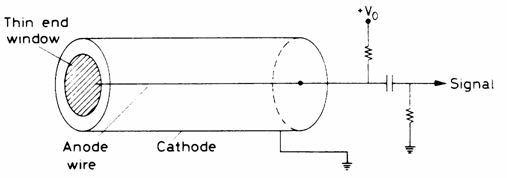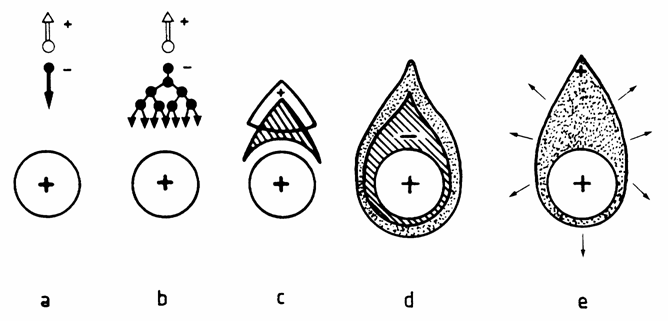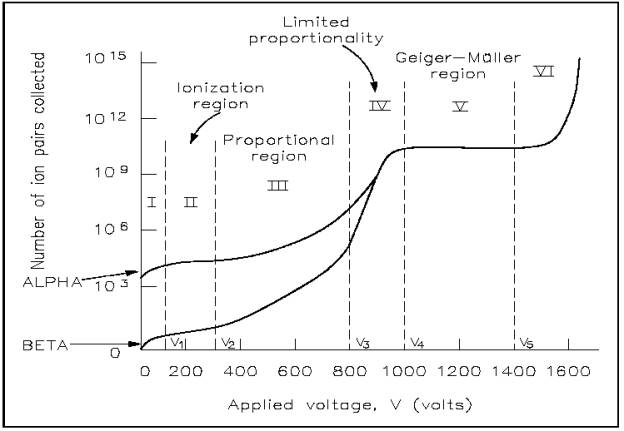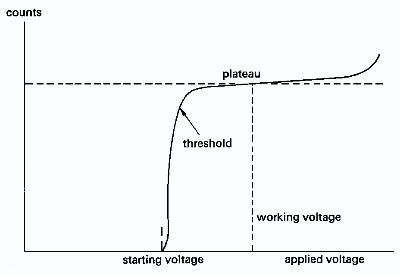Difference between revisions of "Forest IonizationChambers"
| (5 intermediate revisions by the same user not shown) | |||
| Line 39: | Line 39: | ||
At some point(Limited proportionality region) though you start to create enough positive ions that the electric field strength decreases and you get less avalanche even though you are increasing the voltage. | At some point(Limited proportionality region) though you start to create enough positive ions that the electric field strength decreases and you get less avalanche even though you are increasing the voltage. | ||
| + | In this region the number of liberated electrons grows exponentially as they are swept to the anode such that | ||
| + | :<math>N = N_0 e^{\alpha x}</math> | ||
| + | |||
| + | where | ||
| + | : <math>\alpha =</math> first Townsend coefficent | ||
| + | :<math>x =</math> distance from original ionization event and the anode | ||
| + | |||
| + | One can define the amplification A to be | ||
| + | |||
| + | :<math>A= \frac{N}{N_0} = e^{\alpha x}</math> | ||
| + | |||
| + | In reality though the first Townsend coefficent (<math>\alpha</math>) depends on the distance to the anode because the system changes as the charge distribution drop develops. | ||
| + | |||
| + | : <math>\alpha(x) = \sqrt{kN\frac{C V_0}{2 \pi \epsilon_0 x}}</math> | ||
| + | |||
| + | where | ||
| + | |||
| + | :<math>k =</math> korff coefficient (cm^2/V) | ||
| + | :<math>N =</math> number of electrons per unit volume | ||
| + | :<math>C =</math> capacitance of changer /length | ||
| + | : <math>V_0 =</math> Voltage between anode and cathod | ||
= Geiger Muller= | = Geiger Muller= | ||
| Line 49: | Line 70: | ||
[[Image:Forest_IonizationChambers_Electron-IonPairFormation.png]] | [[Image:Forest_IonizationChambers_Electron-IonPairFormation.png]] | ||
| + | |||
| + | [[Image:Forest_IoniztionChamberOperatingRegions.jpg]] | ||
| + | |||
| + | A view for the Geiger Muller operating region. The signal plateaus. | ||
[[Image:GM_Plateau.jpg]] | [[Image:GM_Plateau.jpg]] | ||
Latest revision as of 18:50, 9 June 2008
An ionization chamber is essentially a gas filled volume which has one or more wires suspended inside with a voltage bias used to collect any ions or liberated electrons within the volume.
There are 4 basic operating regions which are determined by the amount of the voltage across the wire(s).
- recombination
- ionization
- proportional (plataue)
- Geiger-Muller
Recombination
Until the voltage reaches a high enough value (threshold), the liberated electrons produces will recombine with the gas before reaching the wire.
Ionization
Once the voltage is increased beyond the above threshold, the ions/ electrons make it to the cathode/anode and produce an electronic pulse on the wire (cathode). The voltage is high enough to attract all of the electron-ion pairs. The pulse height (signal) out of the chamber is independent of the voltage at this point.
quick definitions
- Anode
- Current IN, positively charged electrode
- Cathode
- Current OUT, negatively charged electrode
The flow of electrons is from the cathode to the anode.
Proportional
At a certain voltage though the electron-ions pairs gain enough kinetic energy that they can start to ionization the chamber gas as well. Now the pulse height (signal) out of the chamber depends on the Voltage on the wire.
As the electrons get close to the Anode they see a strong electric field and are accelerated a high enough energy to ionize the chamber gas.
This ionization "amplifies" the original ionization signal strength. The amplification is referred to as the Townsend avalanche and can increase the signal strength by 1000 to 10,000.
At some point(Limited proportionality region) though you start to create enough positive ions that the electric field strength decreases and you get less avalanche even though you are increasing the voltage.
In this region the number of liberated electrons grows exponentially as they are swept to the anode such that
where
- first Townsend coefficent
- distance from original ionization event and the anode
One can define the amplification A to be
In reality though the first Townsend coefficent () depends on the distance to the anode because the system changes as the charge distribution drop develops.
where
- korff coefficient (cm^2/V)
- number of electrons per unit volume
- capacitance of changer /length
- Voltage between anode and cathod
Geiger Muller
At some point the high voltage is high enough that the number of positive ion pairs saturates (you don't create any more even though the voltage is increased). This is called the Geiger Muller plateau. In the Geiger Muller region the signal is independent of the ionizing particle since the signal is already at its maximum.
If you go too high in voltage you will start to have electrostatic discharge making the device give a signal without having any ionizing radiation.
A view for the Geiger Muller operating region. The signal plateaus.



